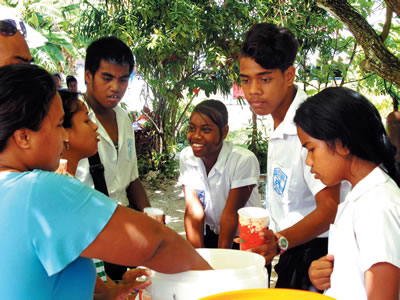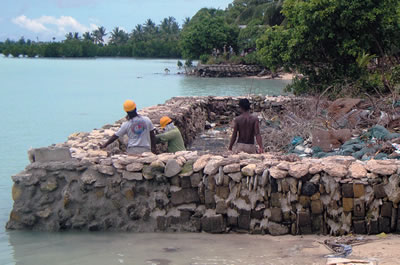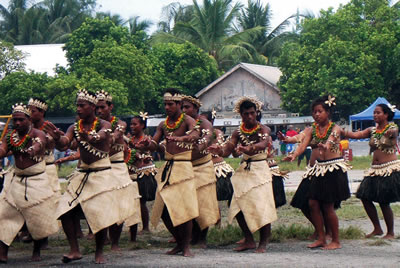
Kiribati is a nation of 100,000 people whose existence is threatened by climate change. The rising sea is making inroads on the low-lying islands. Tarawa Atoll, made up of 30 islets, is the capital and accommodates more than 50% of the population.

Where is Kiribati?
I was having breakfast with a group of Sisters of Our Lady of the Sacred Heart on Tarawa. they spoke about their experience of immigration officials when traveling abroad. One Sister, who had been a missionary in Sudan, said that the Immigration officer there scrutinized her passport and asked, “Where is Kiribati? I have been in immigration for 30 years. I have never seen this country’s passport before.” He examined each page.
“Our Kiribati passport is passed from one offi cial to another,” said another Sister. “y ask us to point out on the map where our country is. they look strangely at the passport. ‘We never heard of that place’ is a regular comment.”
“And how do you feel about all that?” I asked.
“We are sorry for them!” she replied. Surprised, I laughed as she continued, “They just look stupidly at our passport. We know about their countries, but they don’t know anything about ours.”
Kiribati hospitality
I visited Kiribati in the middle of February 2024 to interview Jakobwa, a young man who had asked to join the Columbans. After lunch, two days before I was to leave, my friend Matang drove me to visit Jakobwa’s family. I had asked him to prepare only a cup of tea for our mid-afternoon visit. Arriving at his house I was shocked to see the big feast that was prepared. “Kiribati hospitality,” whispered Matang. Jakobwa’s extended family was present. His sister, the MC, guided us through prayer, introductions, eating and discussion. At the end, I was asked to give them my blessing.

Matang and I continued on to the house of another young man, Tione, who had also enquired about the Columbans. On arrival, we were guided to the inner room which was raised three feet above ground level. His parents and some siblings arrived. After a prayer, introductions and a short talk about Columban missionaries, I answered their questions, with translations done by Matang. In crossing the room for a group photo I was almost decapitated by the low ceiling fan. A combined shouted warning just gave me time to duck.
Just before dark, Matang and I arrived at the family which had invited us for dinner. My host spoke about some important aspects of Kiribati life. He first mentioned the canoe — used for travel, fishing, and racing. Then he cited the maneaba (a communal house with a roof and floor but no walls). It is used for meetings, celebrations, and as a place for guests to stay. It is also a sanctuary for women. If the husband of a woman fleeing from domestic violence follows her to the maneaba, the villagers present will attack the man. It is a sacred place, and proper behavior is required.
Columban companions and the family of Iotobina, wife of Betero Ataniboro, a member of parliament and friend of the Columbans, hosted me for a magnificent dinner on my last night. Their young son is named Columban. Betero was visiting New Caledonia on government business, but he made a video call to speak to us.
Prayer for Protection
Sr. Marie-Therese, the new Provincial of the Sisters, was my hostess during my weeklong stay in South Tarawa. She told me about going by motorbike to a parish at the end of another atoll a year previously. Her 11-year-old niece begged to go too. They stayed there for 4 days. Heavy rain fell and left the dirt road full of pools of water.

As they began the return journey on the motorbike, they said a prayer for protection. Not far from the village, they came suddenly on a large pool of water and the bike skidded. Sister and her young passenger were thrown into the dirty water. They picked themselves up but were covered in mud.
The niece said, “But, Sister, what about our prayer?”
Sister Maria-Therese had to think fast. “Are you hurt?” She asked. “No,” answered the little girl. “Neither am I,” said Sister. “That is the result of our prayer!”
The Majestic Coconut
Although I have been living in the Pacific for more than 40 years, I learned new things about coconuts in Kiribati on this visit. Coconut is ubiquitous in Kiribati. Grated coconut is shaken on rice and morning cereals. Slices of coconut are eaten with a lunch of fish and rice. Today, the sap of the coconut tree is drunk with every meal.
The fibers of large coconuts are made into dance skirts and twine. Brushes or brooms are made from the ribs of the leaf. Medicine is also obtained from the tree. There are numerous words for all stages of development of the coconut and the tree that springs from it.
I remembered the Fijian saying, “Vinaka vakaniu, sega ni biu,” which can be translated “As good as the coconut is, nothing is thrown away!” Let us pray that the nation and people of Kiribati survive.
Columban Fr. Frank Hoare lives and works in Fiji.